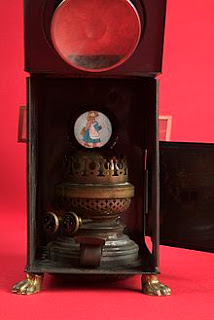 |
| Vintage English illustration claiming Friar and Philosopher Roger Bacon created the first Magic Lantern in the 13th century. From Princeton's Cotsen Children's Library. |
 |
| Advertisement for a triple lensed "Triple Lantern" projector from 1886 London newspaper. The device featured "transitional dissolve," which is achieved through it's three lenses. Found on Wikipedia Page. |
The question as to the true inventor of the first projection magic lantern is a bit veiled in historical mystery and slight controversy as what is properly the first true lensed projection device, however, it is popularly attributed to 17th century Dutch astronomer and mathematician Christian Huygens, who is said to have invented it to amuse his children. [Just as an aside, with a look at fire lamp lit Magic Lanterns, it is easy to imagine that lantern's of the type illustrated above could have been invented much earlier--whether Roger Bacon actually achieved this can not be known at this time--he is credited with all sorts of "magical" discoveries and inventions--some of which he most certainly had nothing to do with. All one would need is a metal lamp with a carved out image in the middle front section--with a candle providing the light from within.] By the 18th century, these machines were even employed in seances to help dupe the unwary into seeing "real ghosts."
 |
| A painted glass slide for early Magic An example of a simple story of a boy falling into a honey pot. |
The early lanterns made use of painted glass panels that were drawn across the light source and with the use of lenses, then projected at a distance. As with the panel above, they told cute little stories mostly intended for children. Again, this is two centuries before photography. Of course, with the invention of photography, the advancement in these early slide projectors was quite rapid. And with the invention of, by Muybridge, of true series photography, it is not hard to see where inventors such as Edison and his cohorts in the US, and others such as the Lumiere Bros. in France already had a concept of true moving picture through projection (though early films made use of other forms of viewing apparati--such as the Kinetoscope). In fact, these machines could actually project early forms of motion photography. Thus the movies actually began with projection and not photography. It is also worth noting that once the machines were used to project photographs, the notion of hand coloring individual photo stills caught on almost instantly--thus the notion of hand coloring early movies came from this technology as well. To see these machines is action, please check out this fine page from Jack & Beverly's Optical Toys.
 |
| Lamp lit Magic Lantern (from the collection of the Children's Museum, Indianopolis. |
 |
| A Magic Lantern dating from 1818, found in the collections of Musée des Arts et Métiers in Paris |
 |
| A primitive plate Lantern found in a museum in Wymondham, England |
 |
| A Lantern owned by the Smithsonian |
 |
| A Lantern in a collection from The Netherlands |
 |
| A Biunial Lantern |
 |
| A Triunial Lantern from the collection of the Museum Victoria, Australia |
 |
| Another much earlier Lantern in the Museum Victoria collection. |
 |
| Another Museum Victoria lantern, much, much later; dating from between 1913 to 1920, note that it's electric. |
For More: Magic Lantern Society



No comments:
Post a Comment